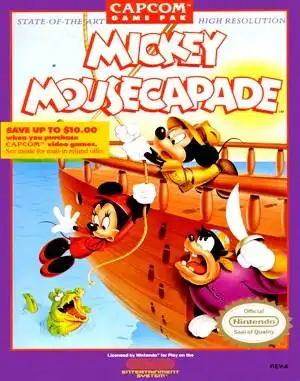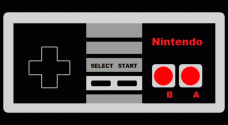Remember the era when Disney characters graced the 8-bit landscape, often courtesy of Capcom? While titles like DuckTales and Chip 'n Dale Rescue Rangers are rightfully hailed as classics, there's another, perhaps stranger, entry that often sparks a mix of nostalgia and confusion: Mickey Mousecapade for the Nintendo Entertainment System. Developed by Hudson Soft and published by Capcom in North America, this game took a slightly different approach to platforming, leading to a truly unique, if sometimes frustrating, adventure.
Let's grab our pixelated mouse ears and jump back into this curious corner of the NES library.
What Exactly Was Mickey Mousecapade?
Released in Japan in 1987 (as simply Mickey Mouse) and North America in 1988, Mickey Mousecapade was a 2D side-scrolling platformer. It wasn't quite the tight, polished experience we'd later expect from Capcom's Disney output, feeling a bit more experimental.
- Developer: Hudson Soft (Japan)
- Publisher: Capcom (North America)
- Platform: Nintendo Entertainment System (NES) / Family Computer (Famicom)
- Release: 1987 (JP), 1988 (NA)
It stood out primarily for its unusual gameplay mechanic: you didn't just control Mickey; Minnie Mouse tagged along!
The Plot: Rescuing... Alice?
The premise is simple enough at first: Mickey and Minnie are on an adventure. However, the goal isn't immediately clear in the North American version. You traverse various whimsical locations – a fun house, a forest, a ship, a castle – battling generic enemies and collecting items. The big reveal, often surprising to players back then, is that you're ultimately trying to rescue Alice from Alice in Wonderland.
This plot point, along with the appearance of certain bosses, highlights one of the game's most notable features: the significant differences between the Japanese and North American versions.
Gameplay: Mickey & Minnie's Odd Couple Adventure
Here's where Mickey Mousecapade gets quirky. You control Mickey directly, but Minnie follows his movements. The challenge (and sometimes the frustration) comes from managing both characters. If Minnie gets hit, she's temporarily stunned or disappears, and you often need both mice present to interact with certain objects or exit rooms.
- Controlling Two: Mickey moves, Minnie trails. You need to be mindful of Minnie's position to avoid hazards.
- Combat: Mickey attacks using projectiles (stars you collect). Minnie is... less useful in a fight, often just getting in the way or getting hit.
- Items: Collect stars for ammo, keys to open doors, and other power-ups like temporary invincibility.
- Challenges: Navigating platforms while keeping Minnie safe, dealing with enemies that require multiple hits, and figuring out obtuse level design in later stages.
It wasn't the most intuitive system, especially compared to the solo heroics of other platformers, but it certainly gave the game a unique feel.
Levels & Bosses: A Whimsical (and Sometimes Frustrating) Journey
The game takes you through five distinct areas:
- Fun House: A classic starting zone.
- Forest: Navigating trees and critters.
- Ocean/Ship: Platforming on water and a pirate ship.
- Castle: A maze-like structure.
- Wonderland: The final stretch to rescue Alice.
Each area has its own set of enemies and often culminates in a boss fight. Bosses included characters like a giant ghost, a pirate captain, and ultimately, villains from Disney lore. The North American version features Maleficent and the Queen of Hearts as bosses, tying into the mixed-up Disney universe theme. Boss fights were often projectile-spamming affairs, testing your ability to dodge and keep both mice alive.
Japanese vs. US: What's Different?
As mentioned, the Famicom version (Mickey Mouse) had some key distinctions:
- Plot/Characters: The Japanese version was more explicitly tied to Alice in Wonderland and Peter Pan, featuring characters like Alice, the Cheshire Cat, and Captain Hook more prominently. The US version toned down or removed some of these specific references, including the initial reveal that you were rescuing Alice.
- Bosses: Different bosses appeared in each version.
- Enemies & Items: Some standard enemies and collectible items varied.
- Difficulty: Some players report the Famicom version felt slightly harder, potentially due to starting health or Minnie's behavior.
These changes make revisiting the game interesting, offering a slightly different experience depending on which version you play.
The Nostalgia Factor & Reception
Mickey Mousecapade wasn't universally acclaimed upon release. Critics often found the music repetitive, the controls clunky due to managing Minnie, and the difficulty uneven. Some felt it was a lesser effort compared to Capcom's later Disney hits.
However, for many who played it as a kid, it holds a strong place in their nostalgic memories. It was a Disney game on the NES, and despite its flaws, it offered a charming, albeit sometimes bewildering, adventure with beloved characters. Modern players often approach it through the lens of nostalgia, appreciating its quirks and historical context within the NES library and Capcom's relationship with Disney. It's often remembered alongside titles like Adventures in the Magic Kingdom, another slightly odd Disney NES game.
Playing Today: Emulation & Options
Thanks to the power of emulation, experiencing Mickey Mousecapade today is relatively easy. You can often find ways to play classic NES games through legal emulation platforms or by exploring digital archives.
- Emulators: Numerous NES emulators exist for PC, Mac, and mobile.
- Online Archives: Websites like the Internet Archive offer playable versions of many classic games for historical preservation purposes. (Internet Archive)
Just be aware that playing on a keyboard might not replicate the classic NES controller feel!
Final Thoughts: Was it a Gem or Just... Mousecapade?
Mickey Mousecapade isn't DuckTales. It's not a masterpiece of platforming design. It's quirky, sometimes frustrating, and its plot is a bit of a mashup. Yet, it's undeniably memorable. Its unique two-character gameplay, surprisingly dark boss encounters (Maleficent!), and the sheer oddity of rescuing Alice make it stand out.
For retro gamers, especially those with a soft spot for Disney or the early days of Capcom's licensed titles, Mickey Mousecapade is worth revisiting. It's a fascinating artifact of the 8-bit era, showcasing a time when developers were still experimenting with how to bring beloved characters to life in pixelated form, for better or sometimes, for weirder.
FAQ
Q: Who is the friend Mickey and Minnie are trying to rescue? A: In the North American version, it's revealed late in the game that they are trying to rescue Alice from Alice in Wonderland. The Japanese version is more explicit about this from the start.
Q: Is Minnie Mouse playable? A: No, you only directly control Mickey. Minnie follows behind him automatically, and her position is crucial for avoiding damage and progressing through certain areas.
Q: Are the Japanese and US versions very different? A: Yes, there are notable differences in plot details, character appearances (especially bosses), enemies, items, and potentially difficulty nuances.
Q: Is Mickey Mousecapade a hard game? A: Opinions vary. Managing Minnie adds complexity, enemies can be "spongy" (taking many hits), and some level designs are tricky. It can be challenging, especially for newcomers to retro platformers.


